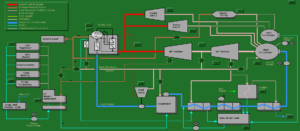Introduction
The intention of this Manual is to supplement any Marine Engineering Knowledge course that contain Steam Knowledge component. The exercises will bring hands on element into theoretical study with high degree of fidelity. It would be particular useful to the students involved into Marine Engineering Cadet Program in their year 3 and 4 of studies.
It is assumed that students are familiar with the work station keyboard lay out, function keys, starting up procedure, managing alarms and saving exercises from the previous experience with MC 90 Simulator.
Propulsion Plant Model
The ERS SP Dual Fuel simulate a large Liquefied Natural Gas carrier with a steam turbine propulsion plant modeled with fixed pitch propeller directly driving a single propeller.
Main Turbine
KAWASAKI UA-400 Cross compound, impulse, double reduction geared marine turbine. This unit consists of one high pressure turbine, one low pressure turbine including astern elements, maneuvering valve unit and reduction gear.
Output at MCR 36.800 PS
Revolution HP Turbine 4990 RPM
LP Turbine 3294 RPM
Propeller 88 RPM
Steam Pressure 60 bar
Steam Temperature 510 C
Main Boiler
Mitsubishi Heavy Industries 56/49 (MB-4B-NS)
Maximum Evaporation 59.500 kg/h
Normal Evaporation 49.000 kg/h
Steam Condition 61 bar super heated steam at 515 C
Safety Valve Settings
Drum High Set 78.0 bar
Superheater 64.5 bar
Ship electrical power generation particulars:
- 2 turbine generators rating at 450 V, 60 Hz, 3450 kW
- 2 diesel generators rating at 450 V, 60 Hz, 3450 kW
One turbine generator is used during normal sea going conditions.
Two generators are required when:
- Maneuvering
- Cargo loading
- Cargo discharge
Steam plant overview


